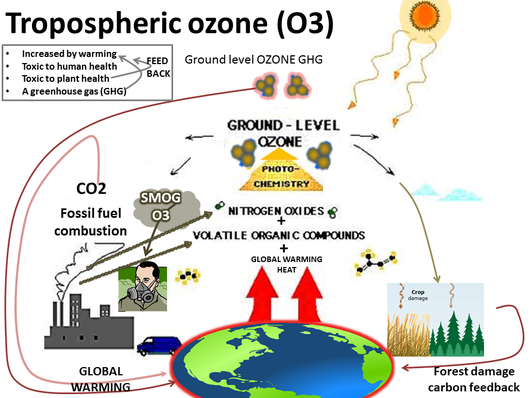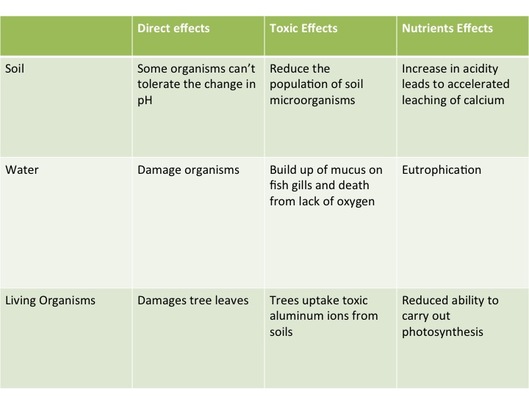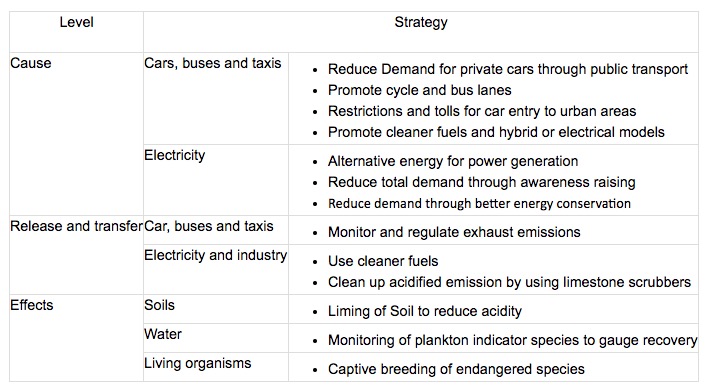6.3, 6.4: Atmospheric Systems and Societies
6.3 - Photochemical Smog
Combustion of fossil fuels produces primary pollutants which may generate secondary pollutants and lead to photochemical smog, whose levels can vary by topography, population density and climate
- Photochemical smog has significant impacts on societies and living systems
- Photochemical smog can be reduced by decreasing human reliance on fossil fuels
Primary Pollutants: from the combustion of fossil fuels include carbon monoxide, carbon dioxide, black carbon/soot, unburned hydrocarbons, oxides of nitrogen, and oxides of sulfur
In the presence of sunlight, secondary pollutants are formed when primary pollutants undergo a variety of reactions with other chemicals already present in the atmosphere.
- Tropospheric Ozone is an example of a secondary pollutant, formed when oxygen molecules react with oxygen atoms that are released from nitrogen dioxide in the presence of sunlight
- The nitrogen dioxide released into the atmosphere is highly reactive and damages crops, which creates respiratory illness and damages fabrics and rubber materials
The ozone is found at ground level where it is naturally released by plants and soil where hydrocarbons can be found along with stratospheric ozone. This occasionally migrates down to the earth’s surface. However, these contributions to the ozone are not considered to be harmful to the health of humans or the environment
- More ozone and harmful substances are present in the lower atmosphere due to pollution and human activities.

Smog: is a complex mixture of primary and secondary, of which tropospheric ozone is the main pollutant
- The frequency and severity of smog in an area depends on local topography, climate, population density and fossil fuel use.
- The ozone and smog are very toxic
Thermal Inversions: occur due to a lack of air movement when a layer of dense, cool air is trapped underneath a layer of dense, warm air
- Deforestation of largely populated forests contributes to smog
Pollution management strategies: include altering human activities to consume less. This will help decrease harmful emissions released into the environment
- This is for regulating and reducing pollutants at point of emission
- The pollution management is supported by government regulations and taxations
- Taxation of people within the country helps the government distribute the money to different functions
- Using catalytic converters to clean CO2 exhaust
- Adopting clean-up measures such as deforestation, re-greening and conservation of areas
6.4 - Acid deposition
Acid deposition: general term for acid coming down from the air
- Acid comes down in the form of rain or snow: wet deposition
- Acid comes down as ash or dry pollutants: dry deposition
- Dry and wet deposition are forms of converted secondary pollutants
The combustion of fossil fuels produces sulphur dioxide, nitrous oxides as primary pollutants
Effects of acid deposition:
- Direct effect: acid on aquatic organisms and coniferous forests
- Indirect toxic effect: increased solubility of metal on fish
- Indirect nutrient effect: leaking of plant nutrients

Pollution Management strategies for acid deposition:
- Altering human activities to reduce the use of fossil fuels
- Regulating and monitoring the release of pollutants through catalytic converters
- Replacing: switching to the use of renewable energy (reducing the use of fossil fuels), use less automobiles and more public transportation, increase energy efficiency
- Regulate: install catalytic converters to reduce carbon emissions produced by factories and automobiles
- Restoring: add lime to forestry plantations to increase the use of natural resources and forests (decreases the need to export and import which is harmful for the environment)
- Cleanup and restoration measure includes recolonisation of damaged systems

In the atmosphere, acid deposition travels with wind and water vapour
- Adopting a sustainable way of living helps the environment and aids in the preservation of natural resources as well.
- A greener lifestyle can be implemented by intergovernmental agreements which aids in the mission of the 17 SDG Goals
The impacts of acid deposition may be limited to areas downwind of major industrial regions but these areas may not be in the same country as the source of emissions.